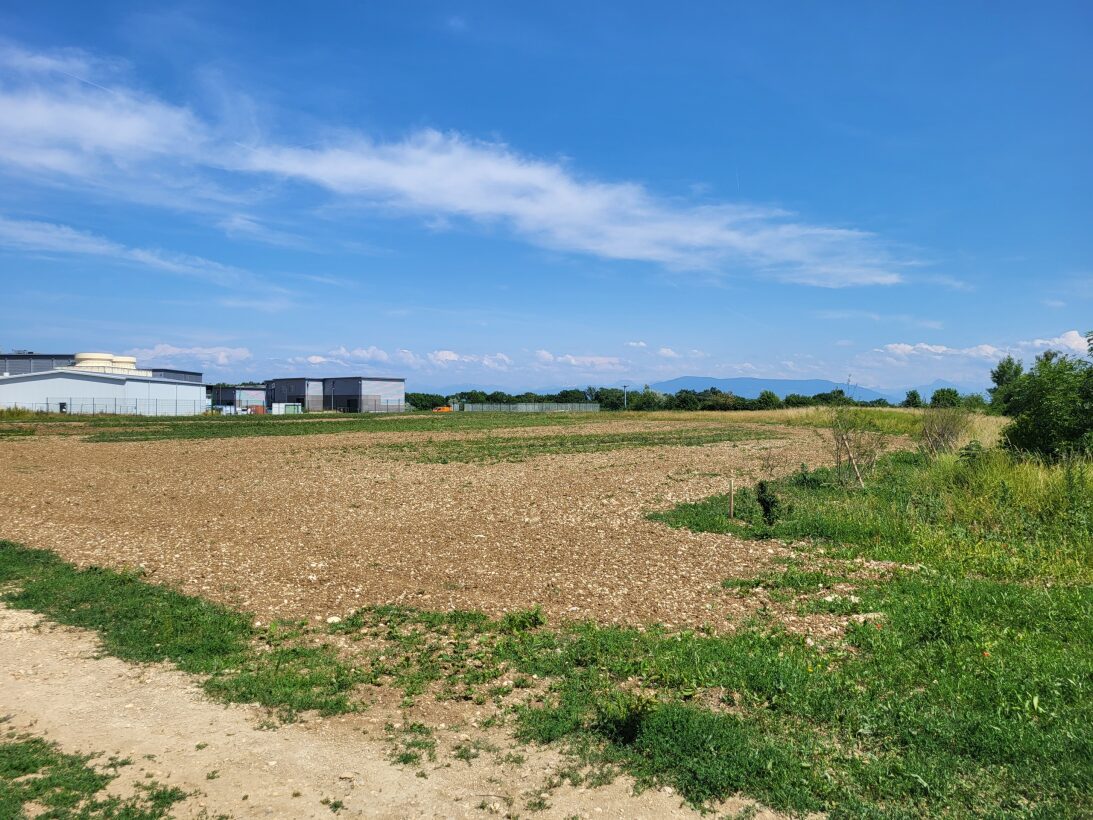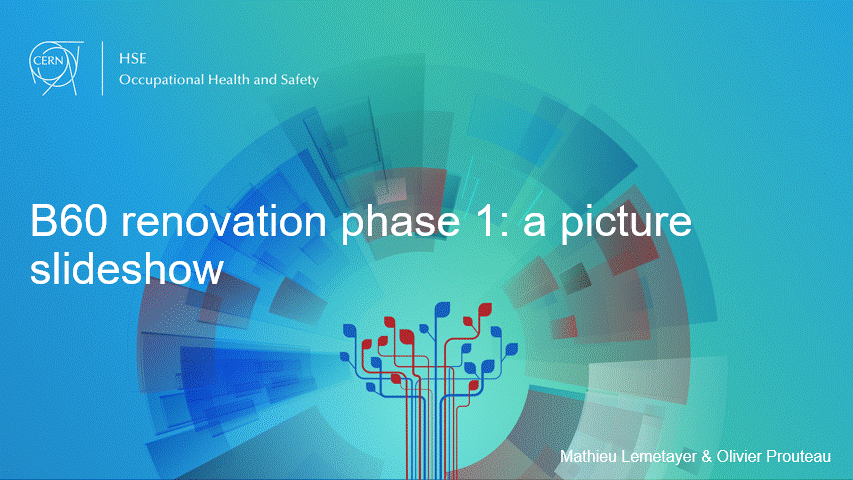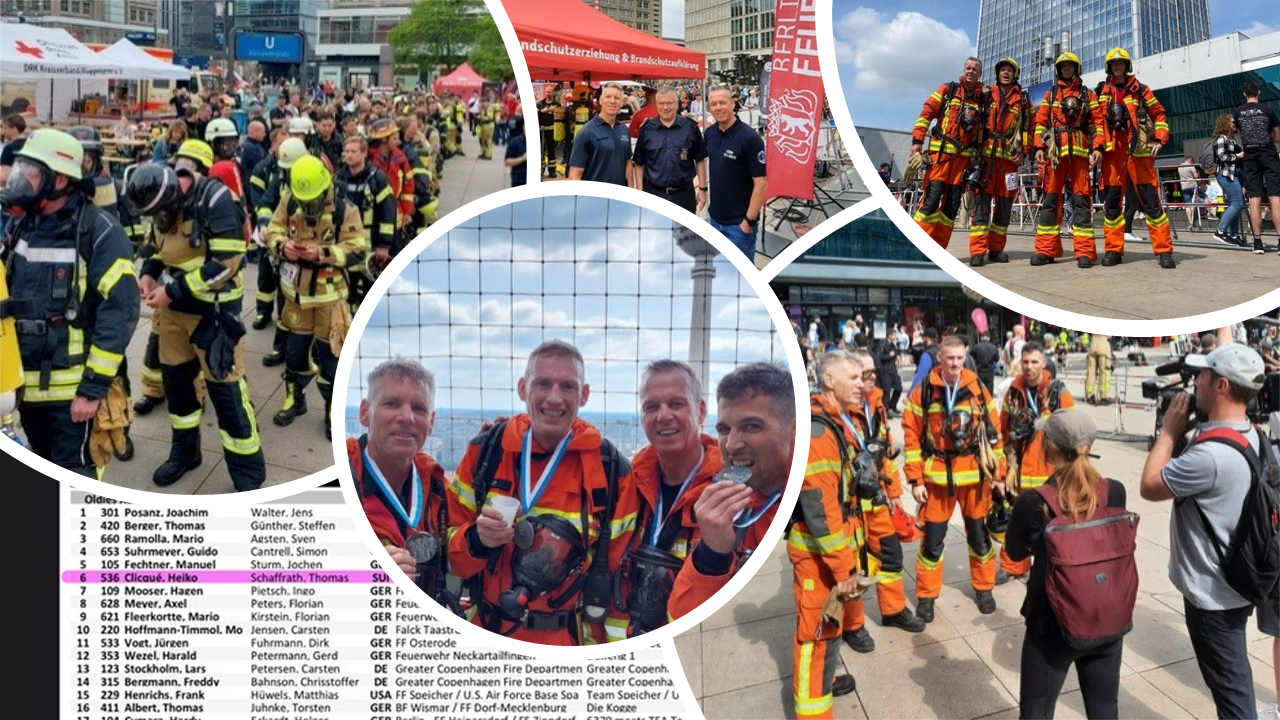
June 2024
Welcome to the HSE Newsletter, which is published at least twice a year and features some selected highlights for the HSE Unit. You can find the other editions here or in the side menu.
We thank the contributors and encourage anyone who has a newsworthy story to share it with us at hse-comms@cern.ch. We will then publish it on the most appropriate channel, including the CERN Bulletin or the HSE website.
A PDF-version of this newsletter is available on EDMS.
Happy reading!
Contents
- So long Yves... et merci!
- The CFRS put their skills to the test
- Turning waste into a resource: finding innovative solutions for FCC excavation material
- Genesis and lifecycle of a Safety rule
- Building 60's renovation
- In brief
- HOR project: all you need to know in the dedicated webpage
- The HSE Safety video is now available in French
- Help with your day-to-day administrative questions, a new webpage from the HSE-TS-AS team
- End of induction for the 2024 CFRS newcomers, and plans for the future evolution of the programme
- Meanwhile, in Berlin…
So long Yves... et merci!
In June 2024, Yves Loertscher, group leader of the HSE-OHS Group from 2018 to this day will leave CERN for a new chapter in his career. We met up with him for an informal interview, to find out more about his experience at CERN, what lies ahead for him and a few jolly questions to end with (Interview in French)
Click here to view the interview
The CFRS put their skills to the test
Imagine the scenario: during a routine transport operation in Zone 19, located just behind SM18 at CERN, a radioactive metal piece weighing 10 tons is mishandled, resulting in a serious accident. The piece falls, trapping a colleague from the transport department underneath and causing a moderate a chemical leak. In response, the CFRS is called to the scene together with on-call specialists from EN-HE to respond to this complex situation involving hazardous materials, structural instability, and the need for fast rescue operations.
This scenario may be fiction, but it could be reality.
Click here to read more
This is why operational trainings for CFRS Watch Managers and Firefighter Officers are crucial and take place regularly since 2022. This particular training scenario, which took place on 21 and 22 March, was facilitated by external observers from “Mission Command”. This Dutch company specialises in leadership development and training with a focus on situational awareness and prioritisation skills, following a structured approach to hone effective decision-making and collaboration needed in such emergencies.
Feedback on the training sessions has been very positive, with participants expressing overall satisfaction with the realism and quality of the exercises. The opportunity to train side-by-side with key stakeholders from different departments and groups has been particularly beneficial in building relationships and fostering seamless collaboration. Marc Nas, CFRS operations manager observes, “In order to effectively operate during incident response, it is important to know your partners and invest in building string relationships with them during quiet times”.
For the future, the objective is to expand training opportunities to include joint exercises with other key stakeholders in both surface and underground infrastructures. These will simulate real-life scenarios involving evacuation, first response by CERN workers, incident response by CFRS- and CERN specialists, as well as Host State emergency response. This ambitious goal will require CERN-wide cooperation especially with DSOs, TSOs and on-call specialists to identify suitable sites to create challenging and credible scenarios. This collaborative approach will not only enhance preparedness but also strengthen relationships and streamline emergency response efforts.

Turning waste into a resource: finding innovative solutions for FCC excavation material
Luisa Ulrici, Deputy Head of the HSE-ENV group and leader of the HSE-ENV-SP section tells us more about MATEX and the Open Sky Laboratory. Intrigued? Read on....
Click here to read more
Hello Luisa, you lead the new HSE-ENV-SP section that was created this year. Before we dive into the subject of excavation material from FCC construction and its potential uses, for context can you first tell us more about the section’s activities?
LU - The SP section stands for “Special Projects”. It was created in light of the increasing contribution that HSE is making to the FCC in environment-related matters. It currently covers the development of a strategy for the management of excavated materials, or MATEX for short, on which I work in collaboration with the GRAD Corentin Pueyo, and the contribution to an initial state environmental report for FCC, which is the basis for later evaluation of all environmental impacts linked to FCC, mainly in the hands of Sophie Valette. The section also encompasses activities related to the public facing CERN environment report, led by Anna Cook.
Can you describe MATEX and the journey so far?
LU - At the beginning of the FCC feasibility study, back in 2019, it became clear that a strategy for the management of the excavation material had to be developed to provide proof to the local communities and the authorities of the two Host States that the proposed accelerator infrastructure was “feasible” and had duly taken environmental aspects into consideration. To this end, a working group was set up with a deliverable expected in the framework of the EU-funded FCC Innovation Study, a Horizon 2020 project co-funded by the European Union. The working group included experts in geology (the Montan University Leoben in Austria), in management of large projects (CEREMA, France) as well as in tunnel excavation (CETU, France). The working group received the support of the Office for waste management of the Canton of Geneva (GESDEC). A strategy for the management of the excavated material is now defined in a first document, that will be refined as further information becomes available.
At the same time, an international competition “Mining The Future” was launched to identify viable innovative solutions for the reuse of the molasse, a soft and heterogeneous sedimentary rock that will constitute approximately 95% of the FCC excavated materials and for which no industrial-scale reuse is known at present. The outcome of this competition, that spanned 2021 and 2022, allowed identification of several promising solutions.
In 2023, the FCC team was requested by the Host State authorities to work out how this material could be used as a resource instead of being disposed of as waste. The reflections led to the identification of an integrated approach that combines local and innovative schemes to be able to manage significant amounts of molasse materials in the FCC construction project.
One aspect concerns the online identification, sorting and pre-treatment of the materials during the excavation process. The other aspect deals with the preparation of different re-use pathways of the sorted and pre-treated materials. They include the transformation of the sterile rock into fertile soil for agriculture, forestry and renaturation applications. This is how the idea for the project “Open Sky Laboratory” at CMS Point 5 was born!
An ‘Open Sky Laboratory’ at point 5, that sounds intriguing: can you tell us more about what it is, the purpose and potential?
LU – The project aims at developing and validating an innovative process to transform sterile “molasse” type excavated materials into fertile soil for agricultural use and afforestation, by using agro-ecology principles and a quality assured process. The fertile and reconstructed soil could be used for the renaturation of quarries and roadsides, the restoration of natural systems in case of polluted or depleted soils, or to enhance forest resilience to climate change.
The quality-assured creation of fertile soil is a lengthy, multi-year process and has therefore been chosen as the first large-scale demonstration of the molasse reuse. For the installation of the so-called "OpenSkyLab", a plot of about 10 000 m2 located near LHC point 5 (CMS, Cessy, France), has been made available and will be prepared in collaboration with the SCE and other groups, including EN-CV for the water supply and EN-EL for the electrical- and fiber connection. Molasse originally extracted during the HL-LHC excavations will be transported back to this field to be used in the tests. Initial laboratory analysis will be performed off-site to identify the most suitable mix of molasse and amendments. These will be followed by field tests in a controlled environment (monitoring of the field, weather, and plant growth conditions), using scientific protocols developed by a collaboration of universities who work in this domain.
In line with CERN’s long-standing tradition, this project relies on an open collaboration with academia and industry. Currently the collaboration includes university experts in agronomy, pedogenesis and geology (HEPIA, BOKU, BRGM, Montan University Leoben), industrial partners in soil engineering and phytoremediation (Microhumus, Edaphos), soil treatment techniques (WSP-BG, MS) and in monitoring and supervisory control systems (BECC).
What are the next steps, for Open Sky Laboratory, MATEX and the ENV-SP section at large?
LU - There are many challenges ahead of us! The FCC feasibility study conclusion has been anticipated for the end of this year. In view of the final report, many important aspects of the excavation material management are still to be investigated (cost, organisation of the worksites etc.). In the meantime, the Open Sky Laboratory will be installed and hopefully see the first batch of tests by June 2025, then the project will run for at least three additional years. For this purpose, we recently welcomed in the SP section a Visiting Scientist expert in agronomy, Christiana Staudinger, from the University of natural resources and life sciences in Vienna, who will support us in this fascinating yet ambitious project.
The section will also face the publication of an important report: the fourth public-facing environment report spanning years 2023 and 2024, foreseen in Autumn 2025.
This will substantially contribute to another important report for the FCC, the initial state environment report will certainly keep us busy in ENV-SP up to the outcome of the European Strategy for Particle Physics!

Plot of land at CMS Point 5 dedicated to the Open Sky Laboratory
Genesis and lifecycle of a Safety rule
If you haven’t taken an in-depth tour of the HSE website, you may be aware of the notion of Safety rules but probably wonder why and how they are developed and how they evolve over time. Our very own HSE legal expert, Angela Goehring-Crinon gives us a whistle-stop tour of this most fascinating ecosystem.
Click here to read more
Angela, in essence what is a Safety rule?
AGC – As an intergovernmental organisation CERN has the right to establish its own regulatory framework as necessary for its functioning. CERN thus establishes its own labour law, the Staff Rules and Regulations, but also a set of Safety rules that provide a clear framework regarding occupational health and safety, including radiation protection, environmental protection as well as the safe operation of CERN’s facilities. The Safety rules cover many different technical domains, such as, ionizing - or non-ionizing radiation, mechanical safety, or chemical safety, but also the different populations present on the CERN site, from CERN staff, users, contractors to visitors.
There are various types of Safety rules, reflecting the hierarchy that you normally find in national systems as well.
What documents are these specifically?
AGC - The Safety Regulations (SRs) define the general Safety principles and responsibilities applicable to a given Safety domain. They are comparable to laws in national legal systems. Prior to 2006 this type of rule was called a “Safety Code”.
General Safety Instructions (GSIs) regulate a specific field of activity or category of equipment within a Safety domain and Specific Safety Instructions (SSIs) regulate a specific activity or type of equipment or component within a field of activity or category of equipment. These rules are similar to ordonnances or decrees in a national system. Prior to 2006 they were called “Safety Instructions”.
To help those concerned with their implementation, Safety rules are complemented by Safety guidelines that provide explanations regarding the rationale behind a rule and practical guidance. There are also Safety forms, which are templates or checklists designed to facilitate the implementation of a Safety Rule.
A set of Safety rules covering a given Safety domain is called a “Safety cluster”. A cluster is composed of one Safety Regulation and several General- and Specific Safety Instructions.
Why do we need Safety rules?
AGC - A clear legible, up-to-date Safety framework is key to a good Safety culture.
If CERN were a national Laboratory, it would apply the applicable national regulatory framework. Given that CERN’s site straddles the Swiss-French border and that Swiss and French approaches are sometimes quite different, there is a need to define a unique safety framework applicable across the CERN site. Add to this some unique technologies for which no reference national regulations exist, as well as the many different populations and the different legal statuses of CERN contributors (from staff to users, students, to users, visitors and contractors) that the rules need to take into account.
However, when establishing its Safety rules CERN bases itself to the extent possible on relevant regulations in the Host States, as well as applicable European or international regulations and standards.
What is the process for developing a Safety rule?
AGC - There are currently two main triggers for the development a Safety rule: the first is the need to replace old, mostly outdated rules that were adopted prior to 2006 when a new Safety rules system was introduced. As there are quite a few rules to be updated and the resources dedicated to rules writing are limited, the rules team regularly submits a rules revision roadmap to the CERN Safety Policy Committee, SAPOCO for approval.
The second trigger to develop a new rule is the need to regulate a new activity or equipment or close a loophole. Proposals for such new rules are also submitted to SAPOCO for approval and integrated into the roadmap.
I work with a small team to manage the Safety rule development and edition process: Andre Henriques (an HVAC expert in the OHS Group) is in charge of the technical coordination, Myriam Ayass (a lawyer) looks at legal questions and drafting and Ulla Tihinen is in charge of editing, publication and relations with the translation service.
The first phase of the Safety rule development is mainly technical and coordinated by Andre. Together with different stakeholders he looks at lessons learnt as well as at the evolution of the applicable regulations, their implementation at CERN and possible challenges related thereto. At the end of this phase, a “concept”, defining the objectives and main principles of the new rule and, if applicable the outline of the Safety rules cluster is established. The concept is regularly discussed within the team during its development.
In the next phase the concept is presented to HSE Management Board and, once validated, to a broader stakeholder audience, including the DSOC and SAPOCO, but also the Management of Departments potentially concerned by the future rules. During this phase the impact of the future rule on current operations and possible transition measures are carefully examined. Depending on feedback received, the “concept” may evolve significantly and there may be a few iterations. This can take some time, in particular in case of conflicting requests from stakeholders that may be impacted in a very different manner. Ultimately the concept is validated by SAPOCO and the Enlarged Directorate.
Then, in a third phase the drafting starts as a collaboration between us, iterating with stakeholders. The main challenges in the drafting process are to maintain clarity while defining sometimes technically or organizationally complex principles. Also, the devil is often in the detail. During this process Ulla does the regular sanity checks, ensuring references and cross-references follow the many changes that will occur in the editorial process, then coordinates with the translation service.
Once all is finalized, Safety Regulations are submitted to SAPOCO and the members of the Enlarged Directorate for validation, and to the Director General for approval. General- and Specific Safety Instructions are approved by the Head of the HSE Unit.
Once approved, Ulla ensures the Safety rule is published on EDMS and the HSE website, and duly communicated in the Bulletin.
How are Safety rules revised and updated?
AGC - For rules published since 2006 this is a continuous process that works quite well. Updates are considered systematically every two or three years to integrate feedback from stakeholders and lessons learnt. The rules are also updated whenever there are significant changes in the reference legislation. For older rules however, the matter gets more complicated as the revision is much more in depth and it’s like developing a totally new rule! It is also more of a challenge because the impact is greater, following technical progress and regulatory environment changes that all need integrating.
In accordance with the agreed roadmap, the rules team is currently giving priority to the revision of the pre-2006 Safety Codes and instructions related to fire – and electrical safety. Our workplan for 2024 also includes a new rule on laser safety.
Thank you Angela for taking the time to give us all these insights which demystify the Safety rules for us all!
Now your curiosity has taken hold, take a deep dive and find out more here.

Navigating through constraints: how HSE and SCE collaborated to prepare and complete the first key phase of the Building 60 renovation project
Building 60, located above the “Main building’ which hosts Restaurant 1, the bank, the kiosk or perhaps the CAGI information desk, has long been at the heart of the CERN Meyrin site as it was the location of CERN Management offices and one of the main conference rooms. Built in 1959, the it has exceptional architectural value according to the inventory conducted in 2016 by the Office of Monuments and Sites of the State of Geneva. It has not undergone any significant works since its construction, due to the high presence of flocked asbestos. The only significant interventions took place prior to the asbestos ban, such as the addition of a conference room on the 6th floor in 1975 and the installation of emergency exits in 1981.
Since Summer 2023, Building 60 has been surrounded by scaffolding and confined for the removal phase in particular of asbestos, before the major renovation aimed at modernising it, improving its energy efficiency and bringing it into compliance on Safety aspects. Our colleagues in the HSE-OHS group, Olivier Prouteau and Mathieu Lemetayer have been among the key actors in this project, whose importance and constraints are considerable. They told us more about the stages of the project so far, characterised by a close collaboration across CERN services, notably SCE.
Click here to read more
Oliver and Mathieu, we are now in May 2024 and the project is due to be completed in 2025. At what stage are we now?
OP and ML – We have reached a crucial stage, the completion of pollutant removal which has been arduous and complicated – it’s a welcome relief! Now we can fully hand over to SCE who can focus with serenity on the renovation and rehabilitation of the building.
When did it all begin?
OP and ML – Preparation has been key in this major project. Discussions have been held for some time given the complexity and constraints at hand, mainly concerning pollutant removal. We started planning in 2021 with many challenges on the table: SCE had to prepare Building 42 so that it would be fit to welcome the Management and other displaced teams for the duration of the work, and we had to ensure the removal and emptying of all offices and spaces. Only after that could we move on to the critical asbestos and other pollutant remediation phase which is mandatory prior to undertaking any new works. This required advanced studies and analyses.
How did you go about this?
OP and ML – We first carried out a diagnosis of pollutants during the closure of CERN at the beginning of January 2022. This made it possible to determine more precisely the type, location and quantities of pollutants. SCE then called on a specialist consultant to assist us, the SCE/HSE team, throughout this sanitation phase. Following this first diagnosis, we carried out a test site in an office which allowed us to better understand the design of the building and the distribution of pollutants, in particular flocked asbestos.
This was essential to determine how to proceed with a view to developing a technical concept as to how to treat the pollutants, in particular the flocked asbestos. It especially resulted in the creation of a ‘sarcophagus’ from the second to fifth floors to ensure maximum safety. Consultations with Swiss authorities such as SUVA and GESDEC were essential to ensure we covered all possible regulatory constraints, and to validate the technical concept. This was integrated in the call for tender for the pollutants removal works, which also included how the waste generated would be disposed of.
And I understand this was a key point of the project?
OP and ML – Absolutely. CERN’s priority was to ensure the flocked asbestos component of the waste would not go to landfill. A novel technology was used instead, called ‘inerting’ (“inertage” or “vitrification” in French) which involves incinerating the waste by plasma torching in a dedicated facility in France: the process transforms it into a glass-type material, which can be reused in the form of aggregates as a road underlay.
What are the main challenges you faced in this project?
OP and ML – We had to face many and diverse technical challenges owing to the building’s layout, and crucially the delicate matter of the contamination of the screed covering the supporting slab of each floor. Added to this we faced inevitable timescale management issues and meteorological aspects arising from heatwaves or heavy rain. Communication and awareness raising have also been essential as it is such an iconic building and its renovation impacts so many people. It has been incredible teamwork and we’re very happy to have achieved this first phase with limited impact overall.
So what are the next steps?
OP and ML - HSE will be implicated in the next renovation and rehabilitation stage but to a lesser degree and sometime in 2025, the Main Building will be restored to its former glory, freshened up and safe in all respects.
What are your take-aways on a personal level?
ML – It’s been an incredibly interesting and eye-opening journey: a project of this scale is rare in a career. The collaboration with other CERN entities and authorities has been extremely rewarding. I am looking forward to presenting it at the International Technical Safety Forum, ITSF in Japan in June!
OP - For me it has been a project that I have been waiting for, for a long time! It culminated with a presentation in March to the ASCA, the body grouping all asbestos specialists in Switzerland which is quite a recognition in itself. But beyond all the technical aspects, it has been and continues to be a great team effort between SCE, HSE, the specialist consultant and the contractor who carried out the asbestos removal work.

In Brief
Click here to read more
HOR project: a dedicated webpage now available
Launched in 2022, the HSE Operational Response (HOR) project aims to review the operational response of HSE Unit services. A dedicated webpage (requiring login) is now available to explain its scope, context and work- packages. A ‘Project news and updates’ section allows you to keep abreast of developments.
The HSE Safety video is now available in French
Following the publication of the Safety at CERN video which has been widely shown on restaurant screens with English subtitles, a French version is now available here.
Help with your day-to-day administrative questions, a new webpage from the HSE-TS-AS team
The HSE website features a one-stop-shop exclusively for HSE members to guide us in the many diverse administrative tasks that come with each working day. Developed by the HSE-TS-AS team, they contain the details of how they can help including an extensive FAQ on questions related to procurement, leave management, training and travel and more.
Further, a glossary of acronyms can help you navigate the CERN jargon with ease.
HSE-TS-AS Section leader, Ulla Tihinen explains: “the development of the new HSE Administrative Services web pages was a joint project with the writing of the GAO roadmaps that we did in 2023. The various administrative procedures have evolved a lot during the last years at CERN and our section needs to be up to date in all of them to be able to answer to our collaborators the most efficiently and rapidly. The new pages offer HSE members an overview of what we do for them and gives a first glance of all the actions. We are here to support and ease the daily work of each of you and hope that these pages will guide you especially to know who to contact and if you are not sure, our generic address hse.secretariat@cern.ch is always available!”

End of induction for the 2024 CFRS newcomers, and plans for the future evolution of the programme
Every year, on 4 May firefighters around the world celebrate Saint Florian’s day: their patron saint. What better occasion to celebrate the completion of the induction of the firefighters that have recently joined the CFRS? As 4 May was on a weekend, the celebration took place on Monday 6 May in building 65. Margaret and Samantha (better known as Maggie and Sammie) from the U.K., Matthias from Belgium, Emil from Norway, Pauli from Finland and Florent from France received their official blue CFRS T-shirt, replacing the red T-shirt they had worn for the duration of their induction.
Eric Herbé, firefighter Officer who manages the induction programme reminds us what it is about and tells us about his for the future newcomers:
“The newcomers induction and training of new firefighters at CERN is a crucial step for their integration in the CFRS, constituting the first link in their journey within the Organization. For three years now, this training has been extended from 4 to 10 weeks, starting on their very first day at CERN. The programme covers a wide range of topics, from discovering specific CERN facilities to managing the various risks present on the site. It also aims to transpose the skills already acquired by these professionals with proven experience to the specific requirements of the CERN environment.
Given that newcomers traditionally start in the Spring of a given year, when the accelerators start up after the Extended Year End Technical Stop (EYETS), access to underground facilities is not possible which means they cannot discover these directly during their induction period. This is why, in the spirit of continuous development of this programme, we are going to leverage novel technologies: the next step will be the integration of virtual reality scenarios, allowing even greater immersion in learning, particularly for exploring underground installations when access is restricted.”
Meanwhile, in Berlin…
CERN Firefighters Gunnar, Adrian, Thomas and Heiko represented the CFRS at the largest ever firefighter stair run in Europe. The event took place in Berlin symbolically on St Florian’s day, seeing them climb the 39 storeys of the 110 metre high Park Inn Hotel on Alexanderplatz, fully equipped! The team did very well, coming 6th out of 22 participating teams in their class ranking. This also was a good opportunity for networking and spreading the word about the ongoing CFRS recruitment campaign, distributing flyers and sharing contact details with firefighters from different countries, including Denmark, Poland, Italy, Czech Republic and Germany. Well done to the team!

